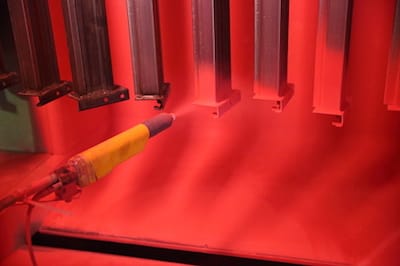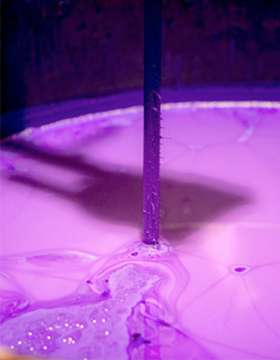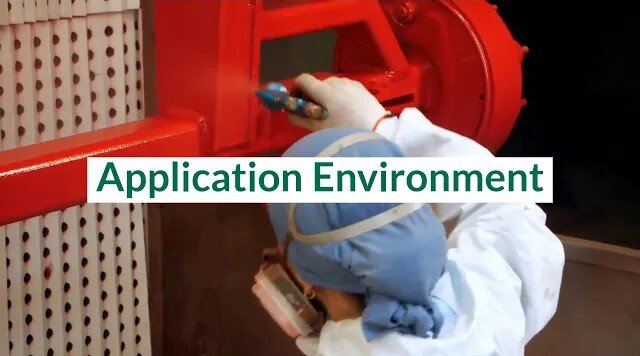Industrial coatings provide more than just an aesthetic finish to on industrial equipment or base materials. Industrial coatings are engineered barriers that protect parts from a wide variety of damages and extreme environments. Concrete, plastics, and metal materials are often strong on their own in many ways, but each of these base materials needs a layer of protective coating that adheres to its surface and protects it from corrosion.
Industrial coatings protect materials and components ranging from infrastructural piping to machinery to floors and other surfaces. These coatings can applied via spray, brush, or dipped, with each application type requiring carefully crafted formulating. Your company’s application method of choice should compliment your production capabilities and create efficiencies rather than bottlenecks.
In addition, industrial coatings do more than protect parts and surfaces from corrosion. Different coating materials can:
- Protect parts from heavy wear, physical impact damage, and/or heat and fire
- Provide non-slip or non-stick surface friction on floors, handles, and machining surfaces.
- Repel dirt, grease, and contaminants with a nonporous topcoat.
Industrial coatings can be found across industrial and commercial settings. Food-safe containers need coatings that prevent corrosion and comply with food safety standards, whereas steel beams may need corrosion-preventing coatings that also withstand certain fire and temperature conditions. Manufacturers who select their coatings and application methods carefully will produce safer products with longer service lives.
Popular applications include:
- Building Materials: Architectural products and engineered roofing and decking systems
- Construction: Tools, heavy equipment, and infrastructure parts
- Consumer Packaged Goods: Canning, commercial containers, plastics
- Manufacturing: Industrial machinery, walking surfaces
Considerations for the Industrial Coatings Process
Selecting the right industrial coating is just one part of a multi-step process. As manufacturers finalize their industrial coating preferences for each of their products, it's important to understand how
surrounding processes like proper surface preparation, selection of application method and equipment contribute to a successful paint line. Some of these processes include:
1. Substrate Surface Preparation
In order for an industrial coating to take hold, the substrate—or the base material receiving the protective layer—must be completely clean. Many industrial coatings rely on a mechanical or physical bond to adhere tightly to the substrate surface. Some coatings even chemically bond with the substrate surface to create a nearly impenetrable layer of protection.
If the surface isn't completely cleared of dust, chemicals, and other contaminants, the industrial coating will likely fail prematurely. Trained industrial coating technicians know how to adequately remove moisture, salts, and dry contaminants with the correct chemical cleaners, heating processes, and blasting procedures.
Properly cleaning surfaces prior to coating prevents damage such as:
- Fish eyes
- Blistering
- Adhesion failure
- Alligatoring
- Bubbling
- Cissing
2. Selecting the Right Coating System for Your Application
Every industrial coating procedure should include priming. Primers help the coating and sealant bind to the substrate's surface for long-lasting performance. Primers help incompatible substrate and coating materials work together and also add to the part's final aesthetic by removing surface-level imperfections. Once the primer is applied, the substrate is ready for coating.
There are several different coating processes. Each method of coating is designed to fully coat the substrate in the protective coating material. However, everything from the substrate's size to its complexity impacts what coating application method is the right fit. The most common coating processes include:

- Spray coating: A spray gun or cartridge applies a thin layer of paint droplets to coat the substrate surface.
- Powder coating: This dry application method often uses an electrostatic charge to apply a thin layer of powder to the substrate. The larger and denser the part, the more energy (and oven space) is required to sufficiently charge the part for coating.
- Dip coating: Complex parts with nooks and crannies can be fully coated through an immersion process known as dip coating. This method ensures that the entire surface is coated, including corners and lips that spraying processes wouldn't normally contact.
- Brush coating: The industrial coating is applied to the substrate with a brush. This is a simple process for commonly used for flat surfaces, such as walls, floors, and beams.
- Roll-to-roll coating: This procedure—also called web-based coating—envelopes the substrate in a thin roll or film of the coating material.
The right topcoat adds additional protective features to the industrial coating. For example, many topcoats can resist damage from UV light, abrasion and physical impact, and moisture among other things.
3. Curing and Drying
Improper curing and drying procedures can make industrial coatings underperform. Every industrial coating should have a Product Data Sheet that specifies the right drying and cure-through procedures for optimal coating results.
Industrial coatings need to be cured at the correct temperature for the appropriate duration. The temperature specifications apply to the temperature of the substrate rather than the temperature of the oven, which is why parts of varying thicknesses often vary in bake times.
4. Inspection
At the end of every coating process, parts should be inspected to ensure the coating is in line with acceptable parameters. Most industrial coatings need to fall within a certain degree of thickness to ensure they adequately cover the part and don’t obscure small details or complexities. Well-run paint lines have quality inspection standards in place to ensure that every coating project falls within acceptable thickness averages.
When selecting the right industrial coating methods, the equipment matters just as much as the coating material. An optimal industrial coatings line requires clean filters and spray tips, strong pump seals, and regularly flushed air lines. Without regular equipment maintenance, results can be substandard or flawed.
Industrial coatings suppliers should work with their customers to ensure they regularly:
- Audit processes with feedback from applicators
- Clean work areas
- Maintain equipment
Key Factors for Selecting a Custom Industrial Coating Formulation
Custom industrial coating formulations create a coating solution perfectly matched to parts and their environments. It's important to consider all potential factors that can impact the substrate—both during the coating process and in the product’s end use environment.
Key factors include:
Substrate Identification
Depending on the substrate, the ideal industrial coating formulation may require acrylic, urethane, epoxy, or other materials. Manufacturers should also consider whether parts are made up of several different materials and when in the total manufacturing process an industrial coating should be applied. Certain substrate and coating pairs can also be bridged by applying the correct primer or incorporating additives to aid in adhesion or enhance other properties.
Manufacturers should also consider what unique protections the substrate requires, such as food safety regulation compliance, corrosion protection, and more. Depending on the substrate's surface conditions and shape, different application methods and materials may offer superior results to others. Some substrates are vulnerable to composition changes through different application methods and curing procedures. For example, a manufacturer working with a plastic substrate paired with a coating that requires a heat cure must ensure the plastic substrate can endure the prescribed bake temperature without warping.
Application Environment
An application’s environmental factors must also be considered for coating selection. Industrial coatings require a stable, clean environment within specific temperature and humidity conditions. Inconsistent conditions in the application environment are often followed by inconsistent finishing results. For example, uncontrolled temperature and humidity settings with warmer, industrially active days and cooler temperatures at night can result in thermal shock.
Exposure to chemical fumes, splashes, and contaminants during the application or drying period can chemically alter the coating. Any contamination before the coating is cured can also reduce its effectiveness. Manufacturers should also ensure that their treated parts are protected from UV radiation, abrasion, and physical impact before curing is complete.
Process Identification
Every detail of the application process impacts the final result. Manufacturers need to carefully plan out the precise application method—such as spraying, dipping, or brushing—and whether the process ensures accurate thickness control. Other process factors for consideration include:
- Substrate preparation
- Baking and curing equipment
- Drying conditions and space availability in controlled environments
- Post-cure cleaning and treatments
Coating Properties
Different paint chemistries exhibit different industrial coating properties. Epoxy and urethane coatings, for example, can withstand a wide variety of chemicals and physical impact. Epoxies can also struggle with exterior exposure. Meanwhile, nitric acid can damage the coating. Water-based coatings are safer for technicians during the application process, but may increase the risk of corrosion in vulnerable substrates.
Ultimately, most of the aesthetic and functional properties of industrial coatings rely largely on the coating material and application process. Those additional properties include:
- Smoothness of film, texture, and gloss
- Coating flexibility and elongation
- Moisture permeability
- Solderability and conductivity for further processing
- Color quality, specificity, and retention
During every step of a custom industrial coating formulation, it's important to take into consideration the part's application use. Application use is one of the biggest factors that determine the coating properties needed to perform its end function.

Industrial Coatings by Aexcel Corporation
Aexcel Corporation carries a wide variety of topcoats, primers, and specialty industrial coating materials to meet your product's substrate and environmental requirements. Aexcel’s chemists and sales engineers work with customers to tailor coatings to perform well in your product’s end use environment while fitting into your manufacturing operation. These products include:
Topcoats
Aexcel's lines of polyurethane, acrylic, and urethane topcoats offer superior protection and aesthetic benefits to substrates such as additional smoothness, color depth, and appealing texture. Aexcel’s existing line of topcoat products can be modified to fit nearly any application or end use specification.
Primers
Quality primers set the foundation for strong industrial coating performance and long-lasting finishes. Aexcel has more than 50 years of experience custom formulating primers for metal, steel, plastic, and wood substrates. Some chemistries Aexcel is basic in include:
- Acrylic
- Alkyd
- Epoxy
- Epoxy ester primers
Specialty Industrial Coatings
Customized specialty coatings can make unique products perform better and stand out from their competitors. Aexcel's specialty coatings provide:
- Antimicrobial finishes for use in medical, aeronautic, and food industries.
- Elastomeric coatings for foam and other flexible substrates.
- Stayseal® blister pack coating that providing excellent anti-blocking and efficiency properties for blister packaging production.
- Soft feel coatings that transform hard plastic substrates to feel like rubber, leather, or other more palatable surface textures.
The right industrial coating should provide the desired aesthetic finish and last for the duration of a product’s useful life. With Aexcel's
custom formulation capabilities, manufacturers improve their products with a high-quality finishes and superior protection.
Our unsurpassed customer service is also at the core of our business. Talk to our chemists, quality control department, and experts any time you have a question or require technical support.
Industrial coatings protect manufactured substrates from corrosion and other sources of damage during the life of a product. Custom industrial coatings offer solutions for unique or complex applications. With Aexcel Corporation's custom industrial coating formulation and manufacturing services, your company's products will be equipped with a finish that protects the substrate, while providing the perfect finish to appeal best to your product’s end user.




